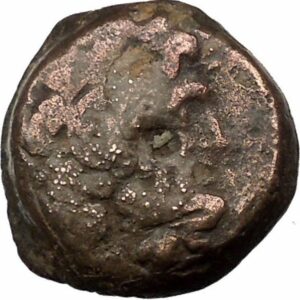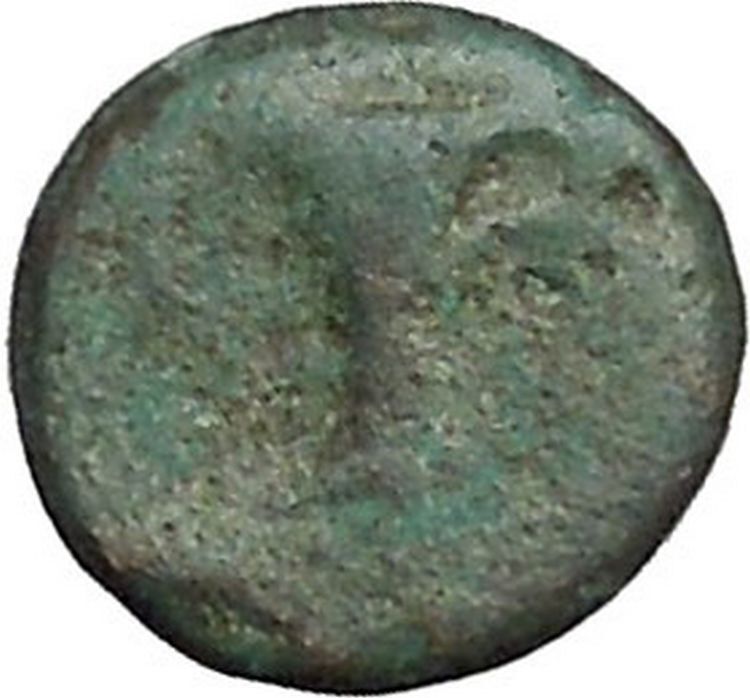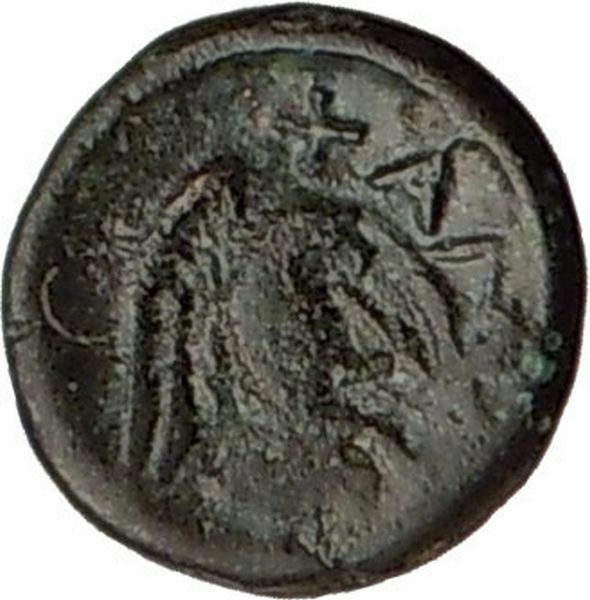|
Greek city of Olynthos in Macedonia
for the Chalkidian League
Bronze 16mm (4.30 grams) Struck circa 420-348 B.C.
Reference: Sear 1433; HGC 3, 511; B.M.C. 5.31; Cf. Robinson-Clement Group M;
SNG ANS 552
Laureate head of Apollo right.
XAΛKIΔΕΩΝ, Lyre.
A colony of Chalkis, Olynthos became the center of opposition to Athenian imperialism in the North, and was the headquarters of the Chalkidian League formed circa 432 B.C. The city was captured and destroyed by Philip II, king of Macedon, in 348 B.C.
You are bidding on the exact item pictured, provided with a Certificate of Authenticity and Lifetime Guarantee of Authenticity.
 In Greek and Roman mythology, Apollo, is one of the most important and diverse of the Olympian deities. The ideal of the kouros (a beardless youth), Apollo has been variously recognized as a god of light and the sun; truth and prophecy; archery; medicine and healing; music, poetry, and the arts; and more. Apollo is the son of Zeus and Leto, and has a twin sister, the chaste huntress Artemis. Apollo is known in Greek-influenced Etruscan mythology as Apulu. Apollo was worshiped in both ancient Greek and Roman religion, as well as in the modern Greco-Roman Neopaganism. In Greek and Roman mythology, Apollo, is one of the most important and diverse of the Olympian deities. The ideal of the kouros (a beardless youth), Apollo has been variously recognized as a god of light and the sun; truth and prophecy; archery; medicine and healing; music, poetry, and the arts; and more. Apollo is the son of Zeus and Leto, and has a twin sister, the chaste huntress Artemis. Apollo is known in Greek-influenced Etruscan mythology as Apulu. Apollo was worshiped in both ancient Greek and Roman religion, as well as in the modern Greco-Roman Neopaganism.
As the patron of Delphi (Pythian Apollo), Apollo was an oracular god – the prophetic deity of the Delphic Oracle. Medicine and healing were associated with Apollo, whether through the god himself or mediated through his son Asclepius, yet Apollo was also seen as a god who could bring ill-health and deadly plague as well as one who had the ability to cure. Amongst the god’s custodial charges, Apollo became associated with dominion over colonists, and as the patron defender of herds and flocks. As the leader of the Muses (Apollon Musagetes) and director of their choir, Apollo functioned as the patron god of music and poetry. Hermes created the lyre for him, and the instrument became a common attribute of Apollo. Hymns sung to Apollo were called paeans.
In Hellenistic times, especially during the third century BCE, as Apollo Helios he became identified among Greeks with Helios, god of the sun, and his sister Artemis similarly equated with Selene, goddess of the moon. In Latin texts, on the other hand, Joseph Fontenrose declared himself unable to find any conflation of Apollo with Sol among the Augustan poets of the first century, not even in the conjurations of Aeneas and Latinus in Aeneid XII (161-215). Apollo and Helios/Sol remained separate beings in literary and mythological texts until the third century CE.
The Chalkidian League (Greek: Κοινόν τῶν Χαλκιδέων, “Koinon of the Chalkideans” or Olynthians or Χαλκιδεῖς ἐπί Θρᾴκης Chalcidians in Thrace to distinguish them from Chalcidians in Euboea) was a federal state that existed on the shores of the north west Aegean from around 430 BCE until it was destroyed by Philip II of Macedon in 348 BCE.
In 432 BCE Olynthos broke away from Athens. Along with several other cities, some form of united state was formed with Olynthos. Exactly what form it took is a matter of academic dispute. By the terms of the Peace of Nicias of 421 BCE, Athens and Sparta agreed that it should be broken up but it seems clear that Athens failed to enforce this. However, because the Chalkidike was no longer the arena of conflict between Athens and Sparta, nothing is heard of it from that time until 393 BCE.
In 393, Amyntas III of Macedon temporally transferred some territory to Olynthos during a period when he was driven out of Macedon by Illyrians. It was restored when Amyntas regained power. Eight years later, Amyntas again in trouble handed over territory, this time to the league. The League were not so ready to return what they held which now included Pella the capital of Macedonia. In 383 BCE, Amyntas appealed to Sparta and at the same time a similar appeal came from Akanthos and Apollonia, two League members who claimed that that membership of the League was not voluntary but enforced at the point of a sword. Sparta was keen to respond to the request. Amongst Sparta’s allies there was no animosity against the Chalkidian League. Nevertheless, when the question was put, fear of annoying Sparta ensured that the proposal was carried. A force of 10,000 was authorized to be sent. An advance force of 2000 was sent under Eudamidas which succeeded in separating Potidaea from the League.
The fighting was long and arduous. Teleutias, the half brother of the Spartan king, Agesilaos (or Agesilaus II), was killed and King Agesipolis suffered heavy losses before dying of fever. However, in 379 BCE the cities of the former League became “autonomous” and subject allies of Sparta. Freeman regards the Spartan dissolution of the League as one of the most “calamitous events” in Hellenic history for, in his view, the League uniting the northern Greek cities with the most hellenised cities of Macedonia would have prevented the rise of Philip II of Macedon, who later destroyed the Chalkidian League.
The actual form of the League is uncertain. It seems it was a genuinely federal state with common laws and coinage and was probably based on the Boeotian League. Political rights are likely to have been reserved to a group of 8000 designated by a property qualification. It included most but not all the Euboean colonies of Chalcidice. The symbol of the Chalcidians was the lyre, struck upon the coins the League.
Olynthus (Ancient Greek: Όλυνθος, named for the olunthos, a fig which ripens early; the area abounded in figs) was an ancient city of Chalcidice, built mostly on two flat-topped hills 30-40m in height, in a fertile plain at the head of the Gulf of Torone, near the neck of the peninsula of Pallene, about 2.5 kilometers from the sea, and about 60 stadia (c. 9-10 kilometers) from Poteidaea.
History
Olynthus, son of Heracles, was considered the mythological founder of the town. The South Hill bore a small Neolithic settlement; was abandoned during the Bronze Age; and was resettled in the seventh century BC. Subsequently, the town was captured by the Bottiaeans, a Thracian tribe ejected from Macedon by Alexander I. The town of Olynthus remained in their possession until 479 BC. In that year the Persian general Artabazus, on his return from escorting Xerxes to the Hellespont, suspecting that a revolt from the Great King was meditated, handed the town over to Kritovoulos from Toroni and to a fresh population consisting of Greeks from the neighboring region of Chalcidice (Herod. viii. 127). Though Herodotus reports that Artabazus slaughtered them, Boetiaeans continued to live in the area.
Olynthus became a Greek polis, but it remained insignificant (in the quota-lists of the Delian League it appears as paying on the average 2 talents, as compared with 6 to 15 paid by Scione, 6 to 15 by Mende, 6 to 12 by Toroni), and 3 to 6 by Sermylia from 454 to 432 .
In 432 King Perdiccas II of Macedon encouraged several nearby coastal towns to disband and remove their population to Olynthus, preparatory to a revolt to be led by Potidaea against Athens (Thuc. 1.58). This synoecism (συνοικισμός) was effected, though against Perdiccas’s wishes the contributing cities were preserved. This increase in population led to the settlement of the North Hill, which was developed on a grid plan. In 423 Olynthus became the head of a formal Chalkidian League, occasioned by the synoecism or by the beginning of the Peloponnesian War and fear of Athenian attack. During the Peloponnesian war it formed a base for Brasidas in his expedition of 424 and refuge for the citizens of Mende and Poteidaea that had rebelled against the Athenians (Thu. ii, 70).
After the end of the Peloponnesian War the development of the league was rapid and ended consisting of 32 cities. About 393 we find it concluding an important treaty with Amyntas III of Macedon (the father of Philip II), and by 382 it had absorbed most of the Greek cities west of the Strymon, and had even got possession of Pella, the chief city in Macedon. (Xenophon, Hell. V. 2, 12).
In this year Sparta was induced by an embassy from Acanthus and Apollonia, which anticipated conquest by the league, to send an expedition against Olynthus. After three years of indecisive warfare Olynthus consented to dissolve the confederacy (379). It is clear, however, that the dissolution was little more than formal, as the Chalcidians (“Χαλκιδῆς ἀπò Θρᾴκης”) appear, only a year or two later, among the members of the Athenian naval confederacy of 378-377. Twenty years later, in the reign of Philip, the power of Olynthus is asserted by Demosthenes to have been much greater than before the Spartan expedition. The town itself at this period is spoken of as a city of the first rank (πóλις μuρἰανδρος), and the league included thirty-two cities.
When the Social War broke out between Athens and its allies (357), Olynthus was at first in alliance with Philip. Subsequently, in alarm at the growth of his power, it concluded an alliance with Athens. Olynthus made three embassies to Athens, the occasions of Demosthenes’s three Olynthiac Orations. On the third, the Athenians sent soldiers from among its citizens. After Philip had deprived Olynthus of the rest of the League, by force and by the treachery of sympathetic factions, he besieged Olynthus in 348. The siege was short; he bought Olynthus’s two principal citizens, Euthycrates and Lasthenes,[1] who betrayed the city to him. He then looted and razed the city and sold its population-including the Athenian garrison-into slavery. According to the latest researches only a small area of the North Hill was ever re-occupied, up to 318, before Cassander forced the population to move in his new city of Kassandreia.
Though the city was extinguished, through subsequent centuries there would be men scattered through the Hellenistic world who were called Olynthians.
Topography and archaeology
The city of Olynthus lies in the hill named Megale Toumba near the village of Myriophyto. The probable site of Olynthus was identified as early as 1902. Between 1914 and 1916 plans were made for an excavation by the British School at Athens, but these fell through.
The ancient city extends in two hills that detach from a small coulee and possess an area with 1500 m long and 400 m in width. Excavations began in 1928. Prof. D. M. Robinson of Johns Hopkins, under the American School for Classical Studies at Athens, conducted four seasons of work: in 1928, 1931, 1934, and 1939. The results of the excavations were digested into fourteen folio volumes. The excavation had uncovered more than five hectares of Olynthus and a portion of Mecyberna (the harbor of Olynthus). On the North Hill this hurried pace proved relatively harmless due to the simple stratigraphy of an area of the city occupied only for 84 years and subjected to a sudden, final destruction; but the data from the South Hill was badly muddled. Nonetheless the work was excellent for its time, and remains supremely valuable. Much of the stratigraphy of the North Hill has been reconstructed by Nicholas Cahill. The site is now in the charge of Dr. Julia Vokotopoulou, and the XVI Ephorate of Classical Antiquities.
The Neolithic settlement is located in the edge of the southern hill and was dated in the 3rd millennium BC. The houses were built by stone blocks and had one or two rooms. The pottery that was found was the typical of that period comprising monochrome ceramic vases. The end of this rural settlement was abrupt and is placed around the first millennium..
The archaic city was built under a provincially urban planning and extended throughout the whole south hill. Two avenues were revealed along the eastern and western edges of the hill that intersected with crossing streets. Along the south avenue shops and small houses were found while the administrative part was located in the north part of the hill, where the agora and a deanery were found.
The classical city was established on the must larger north hill and to its eastern slope. The excavations, which cover only the 1/10 of the city’s total area, have revealed a Hippodamian grid plan. Two large avenues were discovered, with an amplitude of 7 meters, along with vertical and horizontal streets that divided the urban area into city blocks. Each one had ten houses with two floors and a paved yard. Very important for the archaeological research are considered the rich villas that were excavated in the aristocratic suburb of the city located in the eastern part of the north hill since there was found some of the earliest floor mosaics in Greek art.
Both the archaic and classical city were protected by an extended land wall. Parts of the foundations of the wall were revealed in the north hill and elsewhere, but they are not enlightening on which method was followed for their construction. Archaeologists suppose that it was built with sun-dried bricks with a stone base, but it’s difficult to tell, since the city was literally leveled by Phillip.
As it concerns the public buildings, the Agora is placed in the south edge of the north hill, near the eastern gate, along with a public fountain, an arsenal and the city’s parliament building (Βουλευτήριον). There is a small museum featuring artifacts recovered from Olynthus, and the whole archaeological site is open to public tours during daylight hours.
Notable people
- Callisthenes (c. 360-328 BC), historian
- Ephippus (4th century BC), historian
- Euphantus (4th century BC), philosopher
Modern Olynthos
The modern city, formerly Myriophyto, now called Olynthos or Nea Olynthos, sits on a small plateau on the western side of the river Olynthios or Resetenikia (in ancient times known as Sandanus), across from the ruins of the ancient city.
|





 In Greek and Roman mythology, Apollo, is one of the most important and diverse of the Olympian deities. The ideal of the kouros (a beardless youth), Apollo has been variously recognized as a god of light and the sun; truth and prophecy; archery; medicine and healing; music, poetry, and the arts; and more. Apollo is the son of Zeus and Leto, and has a twin sister, the chaste huntress Artemis. Apollo is known in Greek-influenced Etruscan mythology as Apulu. Apollo was worshiped in both ancient Greek and Roman religion, as well as in the modern Greco-Roman Neopaganism.
In Greek and Roman mythology, Apollo, is one of the most important and diverse of the Olympian deities. The ideal of the kouros (a beardless youth), Apollo has been variously recognized as a god of light and the sun; truth and prophecy; archery; medicine and healing; music, poetry, and the arts; and more. Apollo is the son of Zeus and Leto, and has a twin sister, the chaste huntress Artemis. Apollo is known in Greek-influenced Etruscan mythology as Apulu. Apollo was worshiped in both ancient Greek and Roman religion, as well as in the modern Greco-Roman Neopaganism.




